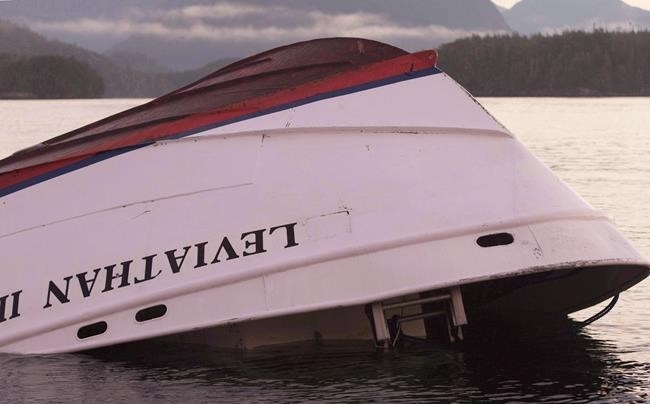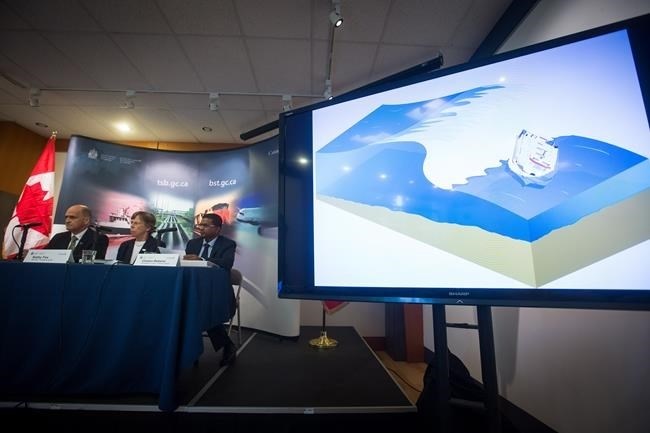
FILE PHOTO - The bow of the Leviathan II, a whale-watching boat owned by Jamie's Whaling Station carrying 24 passengers and three crew members that capsized on Sunday, is seen near Vargas Island Tuesday, October 27, 2015 as it waits to be towed into Tofino, B.C., for inspection.
Image Credit: THE CANADIAN PRESS/Chad Hipolito
June 15, 2017 - 7:00 AM
VANCOUVER - It took 45 minutes before search-and-rescue crews learned that 27 people had been dumped into the frigid waters off Vancouver Island after their whale-watching boat capsized in October 2015, the Transportation Safety Board says.
It was only by chance that a crew member spotted a flare floating in the wreckage and used it to alert nearby fishing boats, said Kathy Fox, head of the federal agency.
The safety board released its investigation of the capsizing on Wednesday, concluding that a large, breaking wave flipped the Leviathan II on October 23, 2015, killing five Britons and one Australian near the resort community of Tofino.
Fewer lives might have been lost had the federal government acted on safety recommendations that were made before the deadly accident, said Fox.
"None of the passengers were wearing life-jackets and, as they struggled to keep their heads and mouths above water in heavy swells, some passengers ingested sea water, oil and fuel," she said.

Animation of the capsizing of the whale-watching vessel Leviathan II off Vancouver Island in 2015 is played as Transportation Safety Board Manager of Marine Investigations Pierre Murray, from left to right, Chair Kathy Fox, and Investigator-in-Charge Clinton Rebeiro, watch during a news conference to release recommendations and findings of their investigation, in Vancouver, B.C., on Wednesday June 14, 2017.
Image Credit: THE CANADIAN PRESS/Darryl Dyck
"When people find themselves immersed in cold water, every second counts, even more so in a rapid capsizing situation like this one.
"Disoriented, separated from loved ones and without any flotation aid, some of them panicked, were struck by debris or simply couldn't swim."
Fox said some of the fatalities might have been prevented had passengers been wearing life-jackets.
The report makes three recommendations, including that all commercial passenger vessels operating beyond sheltered waters carry emergency radio beacons that activate automatically to transmit a boat's position.
The board also recommends that passenger vessels across Canada adopt risk-management processes that identify hazards, such as areas known to have large, breaking waves.
READ MORE: Highlights of TSB report on whale-watching capsizing
In the days after the capsizing, the board said many passengers were standing on the top deck on one side of the ship when a large wave hit the opposite side, rolling the boat and sending the passengers and crew into the water.
The board's investigation determined that neither the structure of the boat nor the location of the passengers when the wave struck contributed to its capsizing.
Clinton Rebeiro, the investigator in charge for the board, said offshore waves travelling over a rising ocean floor and meeting opposing tides can cause waves to become higher or steeper, but determining when that will happen "is almost impossible to predict.""The nature of sea and the process that combine to form breaking waves in shallow areas are complex," he told a news conference in Vancouver.
In the case of the Leviathan II, the wave was about the height of the top of the bridge, Rebeiro said.
Court documents filed last year by Jamie's Whaling Station, the vessel's owner, in response to a civil lawsuit by several passengers describe the event as an "act of God" that could not have been reasonably predicted.
Survivors described being thrown into the ocean without life-jackets, grabbing hold of a single life-ring that floated in the waves.
In a statement, Jamie's Whaling Station said that following the capsizing it has equipped its boats with manually inflatable personal flotation devices to be worn by passengers on outer decks, in addition to the life-jackets that are required by Transport Canada.
It has also reinstated the use of the radio beacons that were recommended by the board, improved radio call-in procedures between its offices and tour vessels, and made it easier to launch life-rafts by installing cradles that do not require lifting by the crew.
Spokesman Ryan Teremy said the company is relieved the report is out and noted that it aligns with crew reports about a large and unexpected wave.
"We're going to take all the recommendations very, very seriously," Teremy said. "Wherever we can advance safety, we will."
The role of the safety board is to investigate marine, pipeline, rail and aviation incidents but it does not assign fault or determine civil or criminal liability.
The RCMP are also investigating the incident and Cpl. Tammy Douglas said Tuesday the file remained open pending the report.
— Follow @gwomand on Twitter
News from © The Canadian Press, 2017